Simmerpan Power Station
INTRODUCTION
The Simmerpan Power Station was the second power station to start generating electrical power under the banner of the Victoria Falls Power Company Limited (VFP) or its subsidiary Rand Mines Power Supply Company (RMPS). The other power station was Brakpan. The Victoria Falls Power Company Limited would change its name to the Victoria Falls and Transvaal Power Company Limited in 1909. Both VFP and RMPS would supply power under separate licences granted by the government in terms of the Transvaal Power Act of 1910.
The power station started generating power in 1909. It, like the Brakpan Power Station, was built to supply the gold mines of the Witwatersrand with electricity. This was at a time when South Africa’s mining industry was expanding rapidly and that expansion depended on the supply of electricity.
The Simmerpan Power Station was built halfway between Germiston and Rosherville on the banks of the Victoria Lake. The power station developed a rich history and tradition that went way beyond just generating and delivering electrical power. It, like other power stations started in the same era, had many personalities and many of the people that worked there grew to see it as more than just a place of work. The power station was part of a larger community of VFP operations built at the same location. There was an electrical test department, stores, the distribution department, and the system control room that controlled outputs from Simmerpan, Vereeniging, Brakpan, and Rosherville Power Stations. The compressed air system to the mines was also controlled from this room. Simmerpan Power Station would be closed down in 1957, 48 years after being opened.
THE EARLY YEARS
Construction of the Simmerpan Power Station began in 1907 and was completed in 1909. At the time of its construction Henry William Montaque Paulet, the Sixteenth Marquees of Winchester, the Premier Marquis of England, was the Chairman of VFP and Major Walter Lewis Bagot, who was a major in the British army was now the general manager in South Africa. The year that it was completed saw the arrival of Bernard Price who became the Chief Engineer of VFP in South Africa.
Originally, the power station was to be constructed at the Rosherville Dam, the site of the Rosherville Power Station. But, because of an agreement with Rand Mines, this plan changed. It was decided to construct it on a location beside Victoria Lake that VFP had obtained from the Transvaal colonial government.
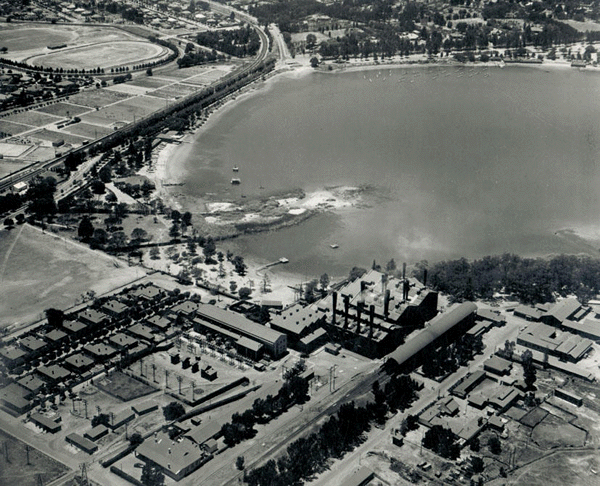
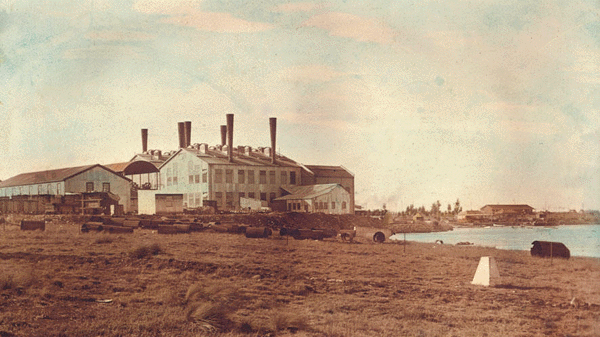
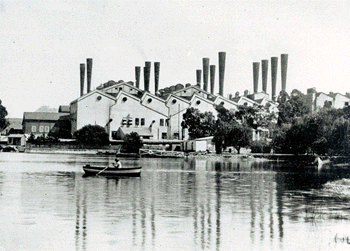
The reason for power stations being built close to water is that it was used to cool the condensing circulating water by natural evaporation. The Victoria Lake contained approximately nine hundred million gallons (4050 million litres) and had a surface area of approximately 180 acres, which was sufficient for the needs of the power station.
The original equipment for the power station was bought from AEG and it consisted of six 3 MW generators and 16 boilers. The power station would connect with the Brakpan Power Station via two 40 000 volt overhead transmission lines and the system would be continued to Bantjies on the West Rand.
This system would form the main interconnecting and transmission “backbone” of the VFP scheme. The construction of Simmerpan lead to the closure of the Driehoek Power Station, which had been taken over when the VFP acquired the General Electric Power Company in 1906. The output from the Simmerpan and Brakpan scheme was capable of meeting the demand for electricity.
This scheme would supply electricity to nine mines owned by the Johannesburg Consolidated Investment Company as well as mines owned by Consolidated Mines Selection, General Mining and Finance, Goerz and Co., Consolidated Goldfields of South Africa, and S. Neumann and Company.
TEETHING PROBLEMS
One of the first problems VFP had to deal with once Simmerpan was built was a previous agreement that the power station was to be built on the property of Vereeniging Estates and the VFP would buy water and coal from them. With both Brakpan and Simmerpan operating, the VFP did not need anymore power stations. The problem was resolved with the construction of the Vereeniging Power Station by the Rand Mines Power Supply in 1912, which placed it conveniently to serve the Rand Mines.
There were also technical problems, these had to be dealt with quickly and effectively or else the consequences would be dire. It is important that power stations maintain the supply of electricity to customers. In Simmerpan’s case, it was even more important, as it was supplying electricity to the mines where, at any given time, had many people working underground. Any interruption could lead to the death of many people. Many of the early problems that effected the power station were linked to the high frequency of lightning storms on the Rand in summer. Many modifications had to be made to the equipment to counteract the lightning
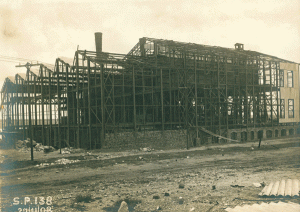
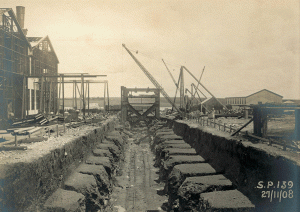
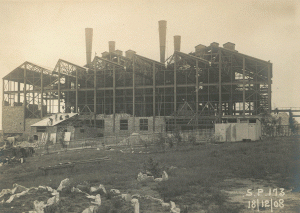
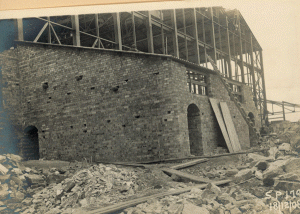
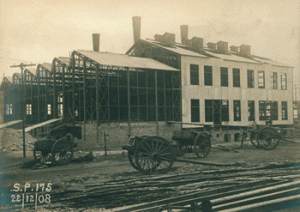
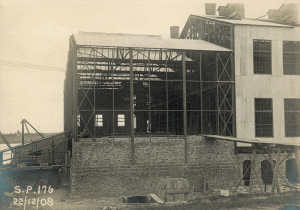
The power station under construction
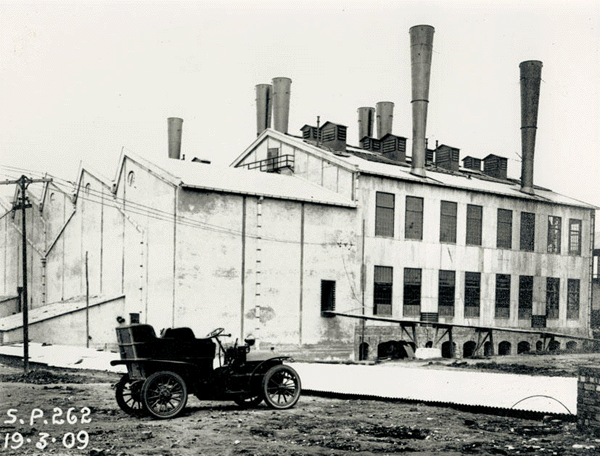
The original generators were designed for generating at 10 000 volts and direct connection to the local overhead reticulation system operating at the same voltage. This was the general design and followed the accepted layout and technique of the original Rand system.
However in the first lightning storm season of their commissioning, practically all of the generators were rendered unserviceable by lightning effects reflected from the overhead network; on one occasion two of them were damaged during a single storm. They had to be rewound for 2 100 volts with a transformer interposed between the generator and the supply system.
There were also problems with the switchgear, as it could not break the heavy fault currents imposed by the lightning. This would often lead to oil fires that lead to the VFP creating fire brigades at each power stations, including Simmerpan.
The vulnerability of the overhead pin insulated lines to lightning was another problem, as they were often damaged leaving the circuit unusable. This was corrected with the development of the “damage proof” line. It involved a high speed sensitive relay protection switching and automatic reswitching which limited the destructive power arc of the lightning to a minimum.
MOVING FORWARD
In the years that followed the establishment of the Simmerpan Power Station, the advantage of using electricity was evident to the consumers due to its cheapness, convenience, and reliability. This increased demand lead to further expansions.
Shortly after the First World War started (1914), two 11 MW generators were added to the Simmerpan. This increased the potential output of the station to 40 MW.
This would be the last extension to any part of the system, as the war would bring all expansion to a halt. This was due mainly to the gradual reduction of the mining industry caused by a shortage of personnel who were released for active service. It was also a time when the costs of running a mine were very high, which had a direct impact on the power stations as the mines tried to cut their power usage.
The end of the War in 1918 did not end the war time problem of rising mining costs. This caused several of the mines to close down. The future was looking bleak for Simmerpan and the other power stations; it was feared that the mining industry had reached its maximum potential and the power requirements of the Rand mines would diminish. This would change in 1922 as the mines efficiency increased and costs decreased after the Rand Revolt was quelled.
1923 saw the end of the arrangement created in 1908 between VFP and the Rand Mines and Corner House Group that saw the RMPS Power Stations, Rosherville and Vereeniging, and the VFP Power Stations, Brakpan and Simmerpan, serving separate mines. It now formed a combined system that was far more reliable and cheaper. It was now one of the world’s major electricity networks. The system was controlled from the VFP’s Control Centre at Simmerpan. The VFP and RMPS now became one organisation from an operational point of view, although in most other purposes it had been one organisation all along.
The outbreak of the Second World War did not have the same effect as the First World War on the mining sector. Although, there was a large number of personnel on active service, this was counterbalanced by the large industrial expansion caused by the need for war supplies and the end of import The control room
The end of the War lead to an expansion of the mining industry and its power requirements. The Simmerpan Power Station had to extend its running hours to meet the demand. The demand was so great that instead of adding onto existing power stations the VFP built more power stations.
On the 16th of June 1948 a formal agreement was signed between ESCOM (the Electricity Supply Commission that was created on the 1st of March 1923 by the government of the day to supply electricity to the country) and the VFP. The VFP sold its shares in RMPS, transferred all staff, assets, and licenses for the price of £14,5 million (R29 million at the prevailing rate of exchange) to Escom. This was the biggest transaction in the history of South Africa up to then. The Chairman of ESCOM at the time was Dr Hendrik van der Bijl. Dr Bernard Price was the Resident Director of the VFP in South Africa and Thomas Otley was the General Manager. Simmerpan now belonged to ESCOM. The area that ESCOM had just gained became known as the Greater Rand Undertaking. This would change twice, and eventually be called the Rand and Orange Free State Undertaking.
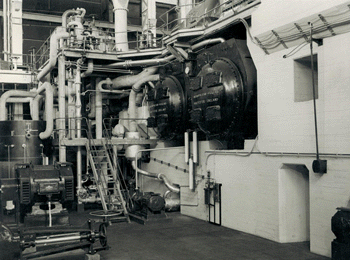
THE END
In 1957, the Simmerpan Power Station closed down after 48 years of service. One of the reasons for the closure was the cost of bringing coal from the mines. Another was the start of the national grid that had no place for the power station. The chairman of ESCOM at that time was Mr. J.T Hattingh.
When Simmerpan closed most of the workers remained loyal to ESCOM and transferred to work in other power stations.
The original building is still standing with part of it used for offices and the rest used as a storeroom. It is now known as the Switchgear building.
In 1968, a new control centre was built on the same site at Simmerpan. “It incorporated the latest telemetering, remote control, and communications equipment. The expanded facilities, workshops, and laboratories served not only the design and testing, but also the monitoring and maintenance functions of the growing countrywide transmission, protection and telecommunications system. It also housed a system simulator and became a central training point for control engineers and operators throughout the country.”
HOUSING AND RECREATION
There were two clearly defined housing quarters at Simmerpan. The one was a series of houses built for the white employees and the other were compounds for the black workers.
There were two types of housing quarters for white employees at the station. There were houses and singles quarter. In 1925, the houses were rented out at between £4 10s and £5 per month and the single quarters at between £1 and £1 5s per month. These were provided with light, coal, water, and sanitary services free of charge.
The black worker compounds were well kept. They were segregated into the various tribal groups. The Compound managers who ran them did not report to the management of the power station, but to the head office of the VFP. There were separate quarters for the indunas (tribal leaders) and their wives and children.
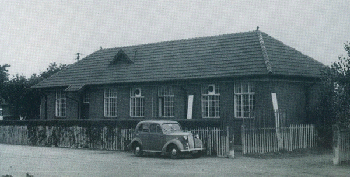
The VFP and RMPS provided tennis courts, bowling greens, a large sports ground, cricket and football grounds, shooting ranges, pavilions, recreation halls, and billiard rooms. These were only for the white workers at the station. All of these facilities played an important role in the everyday life of the power station.
THE WORKFORCE
As already mentioned both white and black people worked at Simmerpan, there were clear divisions between the two as well as divisions within the race groups.
For most of Simmerpan’s life, the majority of the white people at Simmerpan were English speaking and a definite class hierarchy developed. This however would change after the Second World War and especially in 1948. With the National Party coming to power, more Afrikaans-speaking people started working at the power station.
At the top of the hierarchy were the engineers, there were only a few of them, and were mostly from northern England and Scotland. They were extremely loyal to VFP. If there was ever trouble at the station involving other white workers, they could short-circuit the white artisans and operators and keep the station running with the help of unskilled black labour. They were the only employees that benefited from the pension scheme when it was set up in 1925. This would however change with ESCOM buying RMPS from VFP. The middle class was made up of mostly locally skilled supervisors, clerks, and artisans. At the bottom of the hierarchy were the black workers, who were unskilled. They did jobs like removing ashes, off loading and handling coal.
In the high voltage yards black people were not allowed to leave the ground and were not allowed to climb up the switchgear. They were also not allowed to work in the chambers containing the switchgear. There was an occasion when a fire gutted the 10 kV chamber and effected the 40 kV chamber. Once the fire had been put out, special permission had to be gained for the black staff to clear out the debris before the switchgear could be rebuilt.
Most of the black workers were migrant labourers from all over southern Africa. They were recruited by the VFP and RMPS recruitment agency. There were Xhosa’s, Zulu’s, Tsongaan’s and Sotho’s from South Africa and then there were migrant labourers from the neighbouring countries of Mozambique, Rhodesia (Zimbabwe) and Nyasaland (Malawi). There was a hierarchy amongst the tribes with the Zulu’s at the top. Zulus were guardsmen at the power station.
For a long period of time, no women worked at the power station. All work was done by men, including secretarial and receptionist work. Later, this situation changed.
THE CRANES OF SIMMERPAN
There are two cranes at Simmerpan, one yellow the other red. The yellow crane was built in 1908 in the Benrather Maschinenfabrik in Dusseldorf. It has two hooks one for loads of 10 000 kilograms and under and the other for 40 000 kilograms and under. This crane was designed to travel along rails attached to the steel structure of the building to any position over generators 1 to 6. These machines were the first to be installed. Babcock and Wilcox Ltd built the red crane, their offices and factories were in London and Redfred. It has two hooks with the maximum carrying capacity being 50 000 kilograms. This crane could travel along rails to reach any position over generators 7 and 8. This was the extension to the station where the larger and heavier machines stood. The hooks on each crane could traverse to where work was being carried out.
Local staff normally drove the cranes except when they were being overhauled by Maintenance Department. Trained and experienced crane-drivers were then used. The Maintenance Department at Rosherville maintained the cranes and they are still in working order.
LIFE AT SIMMERPAN
In an interview, Mr Jack Andrews, a long time employee of first the VFP and then ESCOM, remembers life at Simmerpan. He started work at Simmerpan at the age of 15 years and 9 months on the 24th of August 1938 as a telephone boy. He would work for about a year at Simmerpan before moving to Rosherville. He would then return to Simmerpan after the Second World War.
Mr Andrews remembers a number of people who worked at Simmerpan during his time there. The man in charge of the telephone exchange was a Mr Brown who had moved out from England because of a lung problem caused by mustard gas poisoning during the First World War. He believed that the fresh air of the Transvaal would ease his suffering. The Resident Engineer (now know as Station Superintendent) when Jack started work was Edgar Smith, whose assistant was Cecil Curry. Cecil’s father had worked for Cecil John Rhodes in the secretarial division and named Cecil after that famous gentleman. He remembers an Electrical Charge Hand, responsible for maintenance, by the name of Frank Mellish whose family was high up in the rugby community of the Western Cape. Another Charge Hand that he remembers is George McRae who fought in the First World War. He was an officer in the 51st Highlander Regiment in France and was awarded a Military Cross for bravery. George’s son, Ian, would go on to become the Chief Executive Officer of Escom.
His time at Simmerpan, both as a boy and as a man, had a big impact on him. He recalls it as a “wonderful” experience with an amazing camaraderie amongst all who worked there. There was a sense of loyalty to VFP amongst the employees; this was the case although they were paid less than people working at the mines. This loyalty was gained because VFP was a “caring company” that provided well for its employees. The VFP established a recreation club and sporting facilities, which Mr Andrews saw as “cementing activities”. These were important to the employees. It was not unusual for people to be allowed time off work to go and do some work on the sport fields or in the recreation club. This emphasised the importance these actually played in the day to day life of Simmerpan. He remembers that George McRae was responsible for looking after the bowling greens.
Another “cementing activity” was the annual Christmas Tree, which was organised by the Recreation Club, of which Jack Andrews was chairman for a year. This involved everyone gathering around the tree, gifts would be handed out to the children of the employees that worked there, and the adults would exchange gifts. Sporting events usually preceded this.
When any of these “activities” took place they were well supported by employees and the class structures mentioned earlier did not exist on the sporting field. At the recreation club employees mixed freely with one another.
These memories emphasise the loyalty of the employees to Rosherville as well as to VFP. This loyalty to the Company would be carried across to ESCOM. Mr Andrews worked for the VFP and then ESCOM for 44 years. It was upon a bedrock of this type of loyalty that VFP and then ESCOM became great.
APPENDIX
Mr. Jack Andrews started work at Simmerpan Power Station, aged 15 years 9 months as a telephone boy. He served his apprenticeship as an electrician at Rosherville. During the Second World War, he worked on the Simonstown dockyards. He returned to Simmerpan Power Station after the War. Jack worked at Vierfontein Power Station as a Shift Engineer where he was promoted to Assistant Resident Engineer (Electrical). He was then transferred to Taaibos Power Station as Assistant Resident Engineer (Electrical). From there he was transferred to Klip Power Station and promoted to Senior Assistant Resident Engineer. He then worked at the Operator Training Department at Klip. Jack moved from there to work at the Central Generating Undertaking (CGU) in Johannesburg as the Senior Accident Prevention Officer in responsible for all Eskom power stations in the Republic of South Africa. The CGU moved to Megawatt Park where he retained the position. He then was made part of the Emergency Preparedness Secretariate. He held this position until his retirement in 1982, after 44 years in service.
BIBLIOGRAPHY
Anon.: Electricity Supply Commission, Twenty-Eighth Annual Report, 1950-51.
Anon.: Photograph at Heritage Conference Centre, Rosherville.
Anon.: Rosherville Power Station Closed Down After 55 years of Service, Megawatt, 1966-67.
Anon.: Souvenir of the visit to Rosherville Generating Station by the members of the Senate and House of assembly of the Union of South Africa, 1925.
Anon.: The South African Electrical Review, August 1957.
Anon.: Power Supply of the Great Rand Mines, The Times. 7 May 1912
Anon.: What Electric Power Means to Reef, Rand Daily Mail, 21 September 1925.
Conradie, S.R. & L.J.M. Messerschmidt.: A Symphony of Power. Chris van Rensburg Publications (Pty) Limited, Johannesburg, 2000.
Rendell, E.F.: Story of Rand’s Power Industry. The South African Electrical Review, April 1956.
Slater, A.: The Birth and Adolescence of the VFP. Megawatt, 1966-67.
